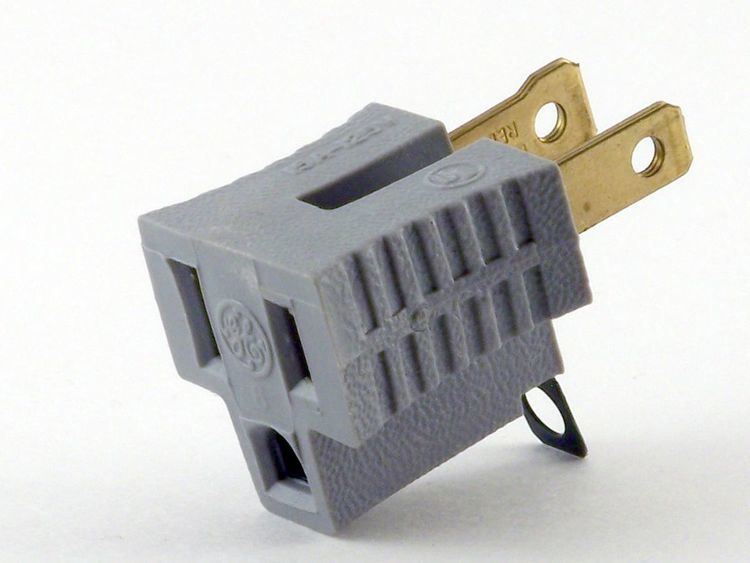 | ||
A cheater plug, AC ground lifter or three-prong/two-prong adapter is an adapter that allows a NEMA 5-15P grounding-type plug (three prongs) to connect to a NEMA 1-15R non-grounding receptacle (two slots). They are needed to allow appliances with 3-wire power cords to plug into legacy ungrounded (two slot) receptacles found in older buildings. The use of such an adapter avoids the need to replace receptacles, but is potentially hazardous if the grounding tab is not connected to electrical ground. A safer and more reliable alternative identified in the US and Canadian electrical codes is to replace the outlet with a Ground Fault Circuit Interrupter (GFCI) breaker outlet.
Contents
Cheater plugs are also used to break ground loops in audio systems. This practice has been condemned as disregarding electrical safety. A safer and more reliable alternative is to use an isolation transformer made specifically for this purpose.
History
Cheater plugs were previously available with a short flexible grounding wire rather than a screw tab. This allows use of the second duplex outlet that does not have a faceplate screw in the correct location for the screw tab. The grounding wire would be wrapped around the adapter to reach the faceplate screw. However, this ground-wire style of cheater plug was discontinued when it was noted that a loose unattached grounding wire could by accident become inserted into the "hot" blade socket of a nearby outlet, potentially leading to electrocution.
Use in residences
Three-prong plugs do not fit into the older, two-prong receptacles. When used as intended, the ground pin of the 3-wire receptacle is to be connected to the grounded cover screw, or to an external ground. In 1969 Underwriters Laboratories mandated three-prong plugs on major appliances for safety. At that time, only half of the receptacles in US homes were three-prong. Wiring in most homes did not include a grounding wire. The screws and outlet boxes were either connected to the neutral, or connected to nothing. Only in rare jurisdictions where non-metallic cable was prohibited and armored cable required (and still in good condition), do cheater plugs work as intended. In 1971, the US National Electrical Code (NEC) required grounded receptacles in all locations of the home (effective January 1, 1974).
Safety
In the professional audio and video fields, the cheater plug has been identified as a serious safety problem. Its casual use as a method for avoiding ground loops in analog audio and video signals (to eliminate hums and buzzes) is dangerous. Bill Whitlock, president of Jensen Transformers, writes, "never, ever use devices such as 3 to 2-prong AC plug adapters, a.k.a. 'ground lifters', to solve a noise problem!" Whitlock relates how an electrical fault in one device that is connected to its electricity source through an ungrounded cheater plug will result in dangerous, high current flowing through audio or video cables. Whitlock notes that in 1997, consumer audio and video equipment electrocuted nine people.
The cheater plug is also recognized as a safety hazard in laboratory settings. For example, in August 2005, Tarun Mal, an associate professor at Cleveland State University, was electrocuted when he plugged a defective fluorescent lamp into a time switch using a cheater plug. Subsequently, the state of Ohio issued seven citations to the university for unsafe electrical conditions. The Scientist notes that four of the University's seven environmental safety experts agreed that use of the cheater plug "is not uncommon in US university labs". Jim Kaufman, CEO of the Laboratory Safety Institute, says, "When you inspect labs, it's not unusual to find anywhere from one to seven that way."
Alternatives
There are several alternatives for connecting newer appliances to two-prong receptacles without rewiring the building: removing the grounding pin of the plug (unsafe), replacing the receptacle with a three-prong outlet (unsafe without proper ground), or replacing the receptacle with a Ground Fault Circuit Interrupter (GFCI).
Removing the grounding pin of the appliance’s plug is unsafe, and leaves the appliance without proper grounding even when relocated and plugged into a properly grounded three-prong receptacle. Additionally, since most NEMA 5-15P plugs have both current-carrying prongs the same width and rely on the ground pin for correct orientation, removing it allows insertion of the plug with hot and neutral wires reversed, creating an additional hazard. In most cases it also invalidates the manufacturer's warranty against defects as an unsupported modification of the appliance.
Replacing the receptacle with the three-prong type and leaving the ground screw unconnected is just as unsafe as using a cheater plug, but has the additional disadvantage that subsequent users of the outlet may not be aware that it is not properly grounded. However, if the ground screw of the receptacle is connected to the neutral side, electric shock is possible even if the appliance is properly functioning. This is called a "false" or "bootleg" ground and is a serious safety hazard often undetected by common receptacle testers.
Replacing the receptacle with a GFCI receptacle is the safest alternative. If a GFCI receptacle is properly functioning, it will interrupt dangerous current to limit the duration of a potentially lethal electric shock from an appliance precisely when the receptacle is not the only conductor to electrical ground (a Ground Fault). For the purpose of protecting humans against electric shocks, the National Electrical Code permits such replacement if the installer marks the GFCI as having "No Equipment Ground".
